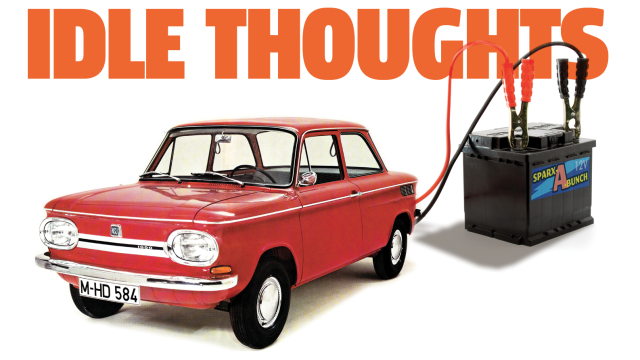I think it’s safe to say that, for most of us, we’re driving a lot less than we used to, what with viruses patrolling the streets, threatening to catch us at every turn, and, as a result, most of our cars are sitting, forlorn and dormant, in our driveways, garages, and ravines. We’ll be covering how to tend to your long-term stored cars soon in detail, but for now let’s just focus on one aspect: your battery, and whether or not it makes sense to idle your car periodically to charge it.
By battery I’m referring to a combustion-engine’d car’s 12V battery, not the far larger and more complex battery of an EV. These car batteries are almost invariably simple lead-acid batteries, and are charged via your car’s alternator (generator on a real oldtimer) when the engine is running.
I’ve recently found that there’s more confusion out there regarding how useful idling is when it comes to charging your battery, so to really get to the bottom of this, we reached out to Scott, an automotive electrical systems engineer at a major automaker, and all I’ll reveal is that he does not work for Studebaker.
Scott told us that the short answer is yes, you can absolutely charge a car by just letting it sit and idle, but you’re unlikely to charge the battery very much unless you’re idling for quite a while.
Scott walked us through some back-of-the-gas-bill-envelope calculations with an example car, a 2019 Toyota Tacoma. I’m paraphrasing what he told me here, so, you know, prepare accordingly.
The Tacoma has a 130 amp alternator, and idles at about 900 rpm. So, if we also factor in a crank pulley that is about seven inches in diameter, an alternator pulley about three inches, which gives us an alternator to rpm ratio of 3:7, then if the Tacoma is idling at 900 rpm, the alternator is spinning at about 2100 rpm, which, according to the performance curve published on the Denso (the alternator supplier) website, then that alternator is putting out about 100 amps at idle.
Scott concluded that this means that with all the lights, HVAC and other electronic toys off, you’re sure to have enough current left over to put some charge back into that battery. How long it will take to charge will depend on the battery capacity and how depleted it was when you started. If the battery was completely dead, getting it back to full charge might take four hours or more. And, if that’s the case, it’s worth remembering that a completely drained lead acid car battery can become chemically unbalanced and then you’re completely boned, at least battery-wise.
We should mention that four hours is not a hard-and-fast rule; there’s a lot of factors at play here, including how depleted the battery was, how many amps your alternator puts out, how fast the car idles, and so on.
Older cars, with few or no computers or other parasitic drains on the electrical system, will likely recharge their batteries faster, even if they have alternators or generators with less output.
So, while idling will recharge your battery, there’s a catch: you have to commit to a pretty long idling session for it to make any sense. Starting your car, as you can imagine, uses a lot of energy, so if you’re only planning to idle your car for, say, 15 minutes or so, you’ll actually be losing more energy than you gain.
Overall, our engineer felt that while idling can recharge your battery, it’s not the most efficient way to do it. The smartest thing to do would be to actually disconnect the battery from the car, by removing the ground cable from the battery’s negative terminal. Or, the positive, I suppose, or both. Just unplug it, is the point, which is exactly what Scott informed us they do with the test cars where he works.
You can then use your shelter-at-home time to read up on how to reset your car’s clocks and radio presets, since you’ll lose those. But, still better than a dead battery.
